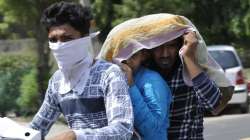India suffers horrid heatwave, Delhi's 2nd hottest April in 72 yrs | 10 points
The heatwave is expected to abate from Monday under the influence of a western disturbance, which is likely to affect northwest India from the night of May 1, IMD said.

India suffered a horrid heatwave on Friday as the temperature touched 47.4 degrees Celsius in Uttar Pradesh's Banda. Delhi recorded its second hottest April in 72 years with a monthly average maximum temperature of 40.2 degrees Celsius.
The India Meteorological Department (IMD) said the heatwave spell will persist over northwest and central India till May 2 and over east India till April 30. An 'orange alert' has been issued for Haryana, Punjab, Delhi, Uttar Pradesh, Rajasthan, Madhya Pradesh, Jharkhand, and the Vidarbha region of Maharashtra for Saturday.
Here are 10 things to note about India's current weather conditions
- Gurugram recorded an all-time high of 45.9 degrees Celsius. Delhi's Safdarjung Observatory, the national capital's base station, recorded a maximum temperature of 43.5 degrees Celsius for the second day on the trot. For Delhi, it is the highest maximum temperature for a day in April in 12 years in the city. Delhi had recorded a maximum temperature of 43.7 degrees Celsius on April 18, 2010.
- Amid the intense heatwave, India's peak power demand reached an all-time high of 204.65 GW on Thursday. Former Congress chief Rahul Gandhi said the Modi government should stop running the "bulldozer of hatred" and start running power plants instead.
- The Delhi government also flagged an "acute shortage" of coal, claiming that many power plants are left with only one day stock and warned of supply disruptions to the national capital, even as Chief Minister Arvind Kejriwal said the situation was being handled somehow.
- The heatwave is expected to abate from Monday under the influence of a western disturbance, which is likely to affect northwest India from the night of May 1, IMD said.
- Rajasthan, Delhi, Punjab and Haryana may witness light rainfall and thunderstorm between May 2 and May 4. The maximum temperatures will be between 36 degrees Celsius and 39 degrees Celsius, senior scientist R K Jenamani said.
- The IMD said the intense heat could lead to "moderate" health concerns for the vulnerable sections such as infants, the elderly and people with chronic diseases. "Hence people should avoid heat exposure, wear lightweight and light-coloured cotton clothes and cover their heads with a hat or an umbrella," it said. There is an increased likelihood of symptoms of heat illness in people who are either exposed to the sun for a prolonged period or doing heavy work, an IMD advisory read.
- According to an analysis by green thinktank Centre for Science and Environment, the early heatwaves that began on March 11 have impacted 15 Indian states and union territories (as of April 24).
- According to D Sivananda Pai of the Kottayam-based Institute for Climate Change Studies, anti-cyclones over western parts of Rajasthan in March and the absence of western disturbances had triggered the early and extreme heatwaves. Anticyclones cause hot and dry weather by sinking winds around high-pressure systems in the atmosphere.
- The All India Power Engineers Federation (AIPEF) claimed that lack of coordination amongst ministries of coal, railways and power is responsible for coal shortage which has caused power outages.
- India saw its warmest March this year since the IMD began keeping records 122 years ago amid a 71 per cent rain deficit. Having recorded three prolonged heatwave spells, this April could be one of the hottest in the history of the country.
(with PTI inputs)